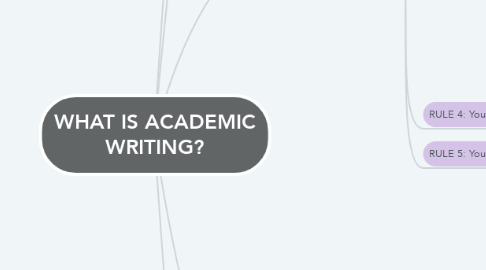
1. DEFINITION
1.1. Formal way of writing
1.2. requires
1.2.1. The use of and specific structure
1.2.1.1. Beginning
1.2.1.2. Middle/Arguments
1.2.1.3. End/Summary
1.2.2. The following of a list of rules and conventions
1.2.2.1. This would make your writing more understandible and easy to read through.
2. CHARACTERISTICS
2.1. Formal
2.1.1. Do not write as you speak
2.1.2. Use accurate grammar, spelling and punctation
2.1.3. Use transitional words or phrases
2.1.3.1. Therefore, As a result, On the other hand,...
2.2. Persuative
2.2.1. Consider the audience you are writing to.
2.2.2. Must defend your arguments clearly and specifically by citing the work of other authors.
2.3. Objective
2.3.1. Cover the facts
2.3.2. Avoid logical fallacies
2.3.2.1. Do not admit something is wrong or right, prove it.
2.4. Responsable
2.4.1. Do not copy
2.4.2. Cite your sources by using APA.
3. RULES
3.1. RULE 1: You must write in sentences
3.1.1. A sentence needs to provide the main clause of it.
3.1.2. Short and clearly sentences are more effective.
3.2. RULE 2: Subjects and verbs in senteces must agree with each other
3.2.1. If the subject is in singular, the verbs must be singular as well.
3.3. RULE 3: You must use appropiate punctuation
3.3.1. Commas
3.3.1.1. Used to denote a weak pause in a sentence.
3.3.1.2. If the sentence is too long replace the commas with full stops.
3.3.2. Dashes and hyphens
3.3.2.1. Use a dash to insert a comment or a short list.
3.3.2.2. Use hyphens to connect prefixes to words or to form compounds.
3.3.3. Exclamation marks
3.3.3.1. They are not recommended for a formal work.
3.3.4. Full stops
3.3.4.1. Used after the end of every sentence.
3.3.5. Question marks
3.3.5.1. They are not recommended for a formal work.
3.3.6. Colons
3.3.6.1. Used to introduce a strong pause in the sentence.
3.3.6.2. Used to separate two clauses that can stand by their own but are linked by the meaning.
3.3.7. Semi-colons
3.3.7.1. Used as a second clause to explain the first one or to describe a sequence of actions.
3.4. RULE 4: You must use the right vocabulary
3.4.1. Do not get confused by two words that sound the same but are written differently, they might have different meanings or uses.
3.5. RULE 5: You must use the apostrophe correctly and with care
3.5.1. Used to indicate the possesive case
4. ACADEMIC STYLE (Academic English AE UK)
4.1. NO
4.1.1. Colloquial/idiomatic words
4.1.2. Phrasal verbs
4.1.3. Personal pronouns
4.1.4. Contractions
4.1.5. Questions
4.1.6. Personal adverbs
4.1.7. Numbers or bullet points
4.1.8. Vague language
4.1.9. Repetition
4.1.10. Basic language
4.2. YES
4.2.1. Passive structures
4.2.2. Academic vocabulary
4.2.3. Referencing systems
4.2.4. Complex grammar structures
4.2.5. Hedging - tentative language
4.2.6. Accurate vocabulary
4.2.7. Precise facts
5. WRITING PROCESS
5.1. Prewriting
5.1.1. Brainstorming of ideas
5.1.2. Choice of a specific topic
5.2. Drafting
5.2.1. Organize your ideas
5.2.2. Create different roughs
5.3. Revising
5.3.1. Add details, quotes and descriptive words.
5.3.2. Try different beginnings and endings
5.4. Editing
5.4.1. Correct punctuation and spelling
5.4.2. Reread and verify that each sentence makes sense.
5.5. Publishing
5.5.1. Type your writing onto a new paper
5.5.2. Create an interesting tittle
5.5.3. Share your work
